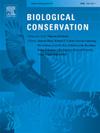Defining optimal small woody features and water densities to maximize European turtle-dove (Streptopelia turtur) occurrence in French agricultural landscapes
IF 4.4
1区 环境科学与生态学
Q1 BIODIVERSITY CONSERVATION
引用次数: 0
Abstract
The European turtle-dove is globally threatened, suffering a widespread and sustained decline in numbers across its breeding range, partly driven by habitat loss. Although the effects of certain habitat features are recognized, questions remain as to which landscape elements should be given priority and in what proportions. We assess how different habitat elements influence the occurrence density of turtle-dove at two management scales (25 and 100 ha), using fine-scale GPS tracking data from 38 turtle doves in France during the breeding season. We found some non-linear responses, with a steeper increase in occurrence density up to at least 25 % small woody features (SWF) density or 10 % water density at a 100 ha scale, refining the proportion to nearly 50 % for SWF at a 25 ha scale. Additionally, at a 25 ha scale, broadleaved forest displayed a bell-shaped trend, indicating a positive effect up to 22 %, whereas vineyards showed a sharp initial decline at a 100 ha scale. Grassland was positively associated with occurrence at the 100 ha scale, whereas fodder, cereal, and broadleaved forest showed negative effects at the same scale, while fodder, build-up, and maize had negative effects at the 25 ha scale. Variable importance analysis revealed that water was the most influential factor at 100 ha, followed by SWF, while at 25 ha, SWF was dominant, followed by water, highlighting scale-dependent habitat preferences. Our study provides insights into the optimal densities of SWF and water resource required for effective conservation, offering valuable guidance for the management and restoration of turtle-dove breeding habitats in agricultural landscapes.
定义最佳的小木材特征和水密度,以最大限度地提高欧洲斑鸠(Streptopelia turr)在法国农业景观中的发生率
欧洲斑鸠在全球范围内受到威胁,其繁殖范围内的数量普遍持续下降,部分原因是栖息地丧失。虽然人们认识到某些生境特征的影响,但关于哪些景观要素应该优先考虑以及以何种比例优先考虑的问题仍然存在。本文利用法国38只斑鸠在繁殖季节的精细GPS跟踪数据,评估了不同生境因素对斑鸠在25和100公顷两个管理尺度下的发生密度的影响。我们发现了一些非线性响应,在100公顷的尺度上,出现密度急剧增加,至少增加25%的小木本特征(SWF)密度或10%的水密度,在25公顷的尺度上,这一比例细化到近50%。此外,在25公顷尺度上,阔叶林表现出钟形趋势,表明正向效应高达22%,而葡萄园在100公顷尺度上表现出急剧的初始下降。在100 ha尺度上,草地与发生率呈正相关,饲料、谷物和阔叶林在相同尺度上呈负相关,饲料、堆积和玉米在25 ha尺度上呈负相关。变量重要性分析显示,在100 ha时,水是最重要的影响因素,其次是SWF,而在25 ha时,SWF是主导因素,其次是水,突出了尺度依赖性栖息地偏好。研究结果揭示了有效保护斑鸠栖息地所需的SWF和水资源的最佳密度,为农业景观斑鸠栖息地的管理和恢复提供了有价值的指导。
本文章由计算机程序翻译,如有差异,请以英文原文为准。
求助全文
约1分钟内获得全文
求助全文
来源期刊

Biological Conservation
环境科学-环境科学
CiteScore
10.20
自引率
3.40%
发文量
295
审稿时长
61 days
期刊介绍:
Biological Conservation is an international leading journal in the discipline of conservation biology. The journal publishes articles spanning a diverse range of fields that contribute to the biological, sociological, and economic dimensions of conservation and natural resource management. The primary aim of Biological Conservation is the publication of high-quality papers that advance the science and practice of conservation, or which demonstrate the application of conservation principles for natural resource management and policy. Therefore it will be of interest to a broad international readership.
 求助内容:
求助内容: 应助结果提醒方式:
应助结果提醒方式:


